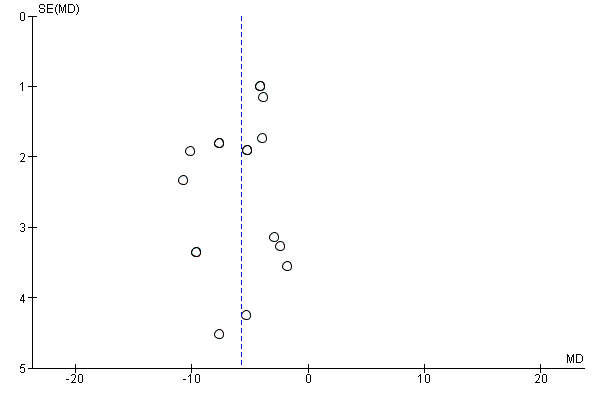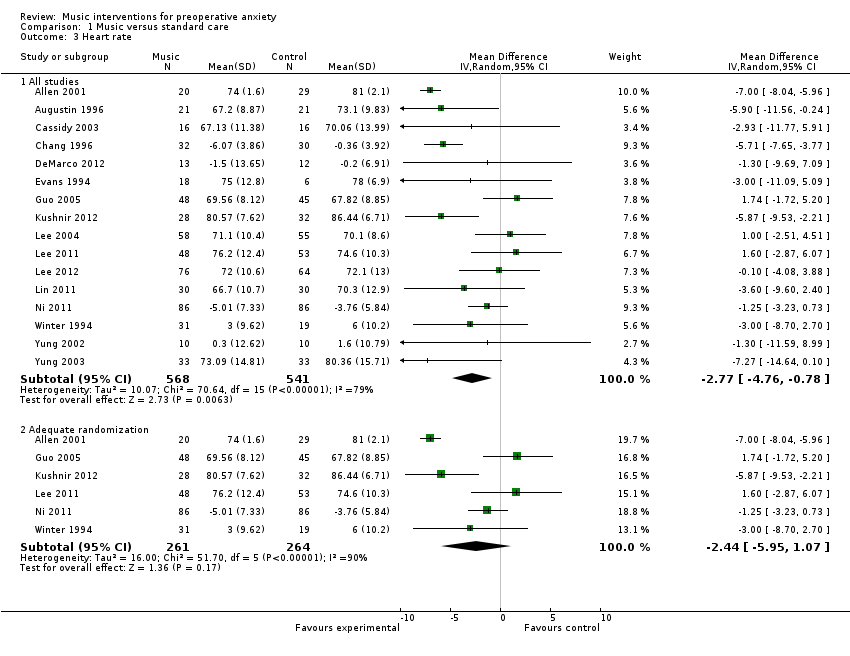Intervenciones con música para la ansiedad preoperatoria
Información
- DOI:
- https://doi.org/10.1002/14651858.CD006908.pub2Copiar DOI
- Base de datos:
-
- Cochrane Database of Systematic Reviews
- Versión publicada:
-
- 06 junio 2013see what's new
- Tipo:
-
- Intervention
- Etapa:
-
- Review
- Grupo Editorial Cochrane:
-
Grupo Cochrane de Anestesia
- Copyright:
-
- Copyright © 2013 The Cochrane Collaboration. Published by John Wiley & Sons, Ltd.
Cifras del artículo
Altmetric:
Citado por:
Autores
Contributions of authors
Conceiving the review: Cheryl Dileo (CD) and Joke Bradt (JB)
Co‐ordinating the review: JB
Undertaking manual searches: JB and research assistants
Screening search results: JB and Minjung Shim (MS)
Organizing retrieval of papers: JB
Screening retrieved papers against inclusion criteria: JB and MS
Appraising quality of papers: JB and MS
Abstracting data from papers: JB and MS
Writing to authors of papers for additional information: JB and MS
Providing additional data about papers: JB
Obtaining and screening data on unpublished studies: JB and MS
Data management for the review: JB
Entering data into Review Manager (RevMan 5.1): JB and MS
RevMan statistical data: JB
Other statistical analysis not using RevMan: JB
Double entry of data: JB and MS
Interpretation of data: JB and CD
Statistical inferences: JB
Writing the review: JB
Securing funding for the review: CD
Performing previous work that was the foundation of the present study: JB and CD
Guarantor for the review (one author): JB
Person responsible for reading and checking review before submission: JB and CD
Sources of support
Internal sources
-
No sources of support supplied
External sources
-
State of Pennsylvania Formula Fund, USA.
This grant only supported the protocol preparation work for this Cochrane review
Declarations of interest
JB and CD are music therapists.
MS: none known
Acknowledgements
We would like to thank Nicola Petrucci (content editor), Nathan Pace (Statistical editor), Claire Ghetti, Fred J Schwartz (peer reviewers) and Ann Fonfa (consumer representative ) for their help and editorial advice during the preparation of this systematic review. We would like to thank and acknowledge Dr Nicola Petrucci (content editor), Dr Fred J Schwartz, Dr M Soledad Cepeda, Prof Bryan C Hunter, and Dr Megan Prictor (peer reviewers) for commenting on the protocol for the systematic review. Finally, we would like to thank Dr Kathleen Murphy for her assistance in retrieval of articles for this review.
Version history
| Published | Title | Stage | Authors | Version |
| 2013 Jun 06 | Music interventions for preoperative anxiety | Review | Joke Bradt, Cheryl Dileo, Minjung Shim | |
| 2008 Jan 23 | Music for preoperative anxiety | Protocol | Cheryl Dileo, Joke Bradt, Kathy Murphy | |
Differences between protocol and review
The protocol title 'Music for preoperative anxiety' has been revised to 'Music interventions for preoperative anxiety'.
Notes
At the time of this review, we identified a published journal article (Beccaloni 2011) that plagiarized a section of the background text of the published protocol of this review (Dileo 2008). After an investigation, the following plan of action was agreed upon: the author will revise the abstract to include quotations around the directly quoted material as well as inclusion of the appropriate reference. This revision as well as an erratum addressing the issue will be published in the Journal of Perianesthesia Nursing 28(2):April 2013.
Keywords
MeSH
Medical Subject Headings (MeSH) Keywords
Medical Subject Headings Check Words
Humans;
PICO

Funnel plot of comparison: 1 Music versus standard care, outcome: 1.1 State Anxiety STAI.

Excluded Study flow diagram.

Risk of bias summary: review authors' judgements about each risk of bias item for each included study.

Risk of bias graph: review authors' judgements about each risk of bias item presented as percentages across all included studies.

Comparison 1 Music versus standard care, Outcome 1 State anxiety STAI).

Comparison 1 Music versus standard care, Outcome 2 Anxiety (non‐STAI).

Comparison 1 Music versus standard care, Outcome 3 Heart rate.

Comparison 1 Music versus standard care, Outcome 4 Heart rate variability ‐ LF/HF ratio.

Comparison 1 Music versus standard care, Outcome 5 Systolic blood pressure.

Comparison 1 Music versus standard care, Outcome 6 Diastolic blood pressure.

Comparison 1 Music versus standard care, Outcome 7 Respiratory rate.
| Patient or population: patients with preoperative anxiety | ||||||
| Outcomes | Illustrative comparative risks* (95% CI) | Relative effect | No of Participants | Quality of the evidence | Comments | |
| Assumed risk | Corresponding risk | |||||
| Standard care | Music | |||||
| Preoperative anxiety (STAI) | The mean preoperative anxiety (stai) ranged across control groups from | The mean preoperative anxiety (stai) in the intervention groups was | 896 | ⊕⊕⊝⊝ | ||
| Preoperative anxiety (non‐STAI) | The mean preoperative anxiety (non‐stai) in the intervention groups was | 504 | ⊕⊕⊝⊝ | |||
| Heart rate | The mean heart rate ranged across control groups from | The mean heart rate in the intervention groups was | 1109 | ⊕⊝⊝⊝ | ||
| Heart rate variability | The mean heart rate variability ranged across control groups from | The mean heart rate variability in the intervention groups was | 241 | ⊕⊝⊝⊝ | ||
| Systolic blood pressure | The mean systolic blood pressure ranged across control groups from | The mean systolic blood pressure in the intervention groups was | 809 | ⊕⊝⊝⊝ | ||
| Diastolic blood pressure | The mean diastolic blood pressure ranged across control groups from | The mean diastolic blood pressure in the intervention groups was | 786 | ⊕⊝⊝⊝ | ||
| Respiratory rate | The mean respiratory rate ranged across control groups from | The mean respiratory rate in the intervention groups was | 375 | ⊕⊝⊝⊝ | ||
| *The basis for the assumed risk (e.g. the median control group risk across studies) is provided in footnotes. The corresponding risk (and its 95% confidence interval) is based on the assumed risk in the comparison group and the relative effect of the intervention (and its 95% CI). | ||||||
| GRADE Working Group grades of evidence | ||||||
| 1 The majority of the trials were assessed as high risk of bias studies | ||||||
| Outcome or subgroup title | No. of studies | No. of participants | Statistical method | Effect size |
| 1 State anxiety STAI) Show forest plot | 13 | Mean Difference (IV, Random, 95% CI) | Subtotals only | |
| 1.1 All studies | 13 | 896 | Mean Difference (IV, Random, 95% CI) | ‐5.72 [‐7.27, ‐4.17] |
| 1.2 Adequate randomization | 4 | 435 | Mean Difference (IV, Random, 95% CI) | ‐5.76 [‐7.94, ‐3.57] |
| 2 Anxiety (non‐STAI) Show forest plot | 7 | Std. Mean Difference (IV, Random, 95% CI) | Subtotals only | |
| 2.1 All studies | 7 | 504 | Std. Mean Difference (IV, Random, 95% CI) | ‐0.60 [‐0.90, ‐0.31] |
| 2.2 Adequate randomization | 3 | 182 | Std. Mean Difference (IV, Random, 95% CI) | ‐0.41 [‐0.71, ‐0.12] |
| 3 Heart rate Show forest plot | 16 | Mean Difference (IV, Random, 95% CI) | Subtotals only | |
| 3.1 All studies | 16 | 1109 | Mean Difference (IV, Random, 95% CI) | ‐2.77 [‐4.76, ‐0.78] |
| 3.2 Adequate randomization | 6 | 525 | Mean Difference (IV, Random, 95% CI) | ‐2.44 [‐5.95, 1.07] |
| 4 Heart rate variability ‐ LF/HF ratio Show forest plot | 2 | 241 | Mean Difference (IV, Random, 95% CI) | ‐0.37 [‐1.16, 0.42] |
| 5 Systolic blood pressure Show forest plot | 14 | Mean Difference (IV, Random, 95% CI) | Subtotals only | |
| 5.1 All studies | 14 | 809 | Mean Difference (IV, Random, 95% CI) | ‐4.82 [‐12.13, 2.49] |
| 5.2 Adequate randomization | 5 | 424 | Mean Difference (IV, Random, 95% CI) | ‐5.80 [‐18.96, 7.36] |
| 6 Diastolic blood pressure Show forest plot | 13 | Mean Difference (IV, Random, 95% CI) | Subtotals only | |
| 6.1 All studies | 13 | 786 | Mean Difference (IV, Random, 95% CI) | ‐2.37 [‐4.03, ‐0.71] |
| 6.2 Adequate randomization | 5 | 424 | Mean Difference (IV, Random, 95% CI) | ‐2.74 [‐5.65, 0.17] |
| 7 Respiratory rate Show forest plot | 6 | 375 | Mean Difference (IV, Fixed, 95% CI) | 0.97 [0.82, 1.11] |

